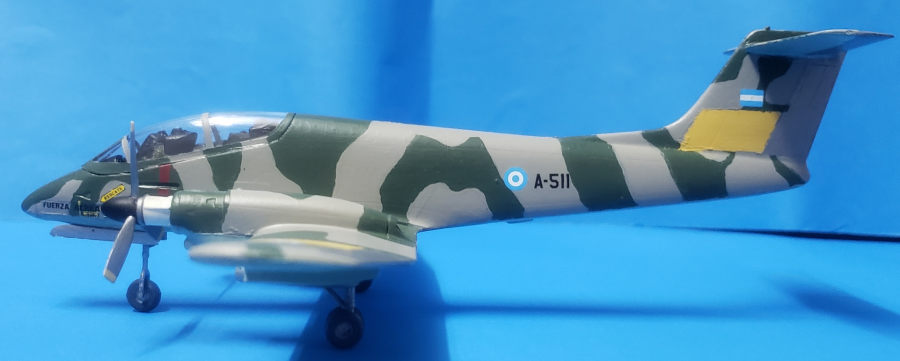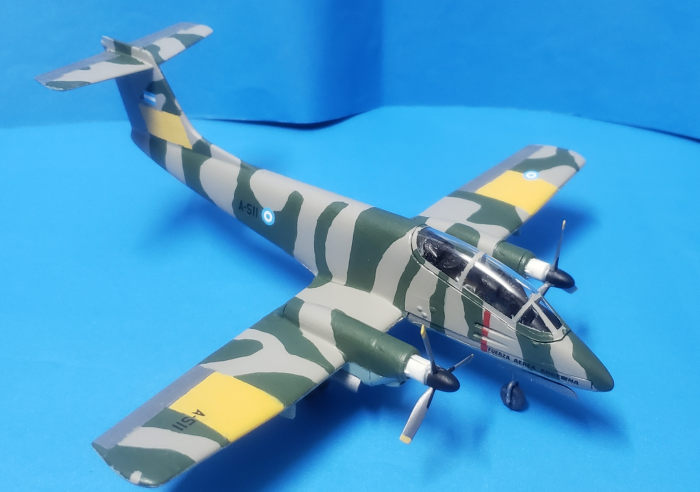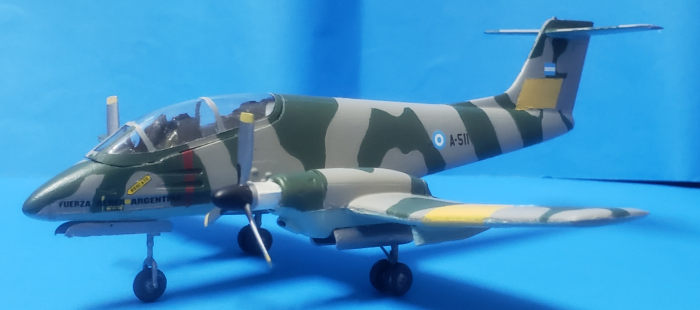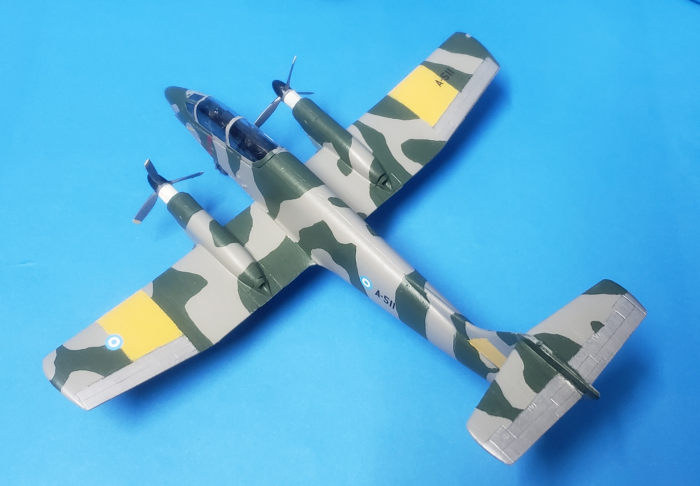
Special Hobby 1/72 IA-58 Pucara
| KIT #: | 72177 |
| PRICE: | 59$ |
| DECALS: | Three options |
| REVIEWER: | Francisco Santoro |
| NOTES: |

| HISTORY |
From the instructions: "In the mid 1960s the Argentinian Air Force issued a specification for a new ground attack aircraft that would be capable of providing close air support for the Army. The requierement was handed over to the Air Force owned Fábrica Militar de Aviones (FMA).
The proposal formally presented to the Air Force on January 29th 1968 was for a twin turboprop, two seat, low wing and T-tailed aircraft that would be capable of low and slow flight in order to accomplish its requiered mission. By August 20th, the first prototype made its maiden flight, powered by Garret TPE-331-U303 engines. Two more prototypes would follow, but problems with the American engines and some strained relations with the US led to the adoption of French Turbomeca Aztazou engines. Shortly after, it was suggested by the wife of one of the test pilots, 1st Lieutenant Digier, that the aircraft be named after the local Quechua indina tribe word for "Fortress." The name Pucará was accepted. The first production example flew for the first time on November 14th 1974, by which time a Pucará Task Group was preparing the base they were destined to operate from: Base Aérea Militar Reconquista, in the province of Santa Fé.a
By the time the first two Pucarás, A-501 and A-502 arrived at the base on August 27th 1975, the country had been steadily suffering from the infiltration of communist guerrillas, mainly from neighbouring Bolivia, in the northern border areas of Argentina. The Argentinian Army managed to get authorization to mount Operación Independencia to remove the threat from Argentinian soil. During the successful operation, four Pucarás operated in support of the Army from the Military Aviation School in the province of Córdoba.
 Tension
with neighbouring Chile at the end of 1978 saw the Air Force deploy all of
its Pucarás to two bases in the Patagonia: BAM Puerto Santa Cruz in the
province of Santa Cruz, and BAM Fuerte General Roca in the province of Río
Negro. Fortunately common sense prevailed and the aircraft returned to
normal status shortly thereafter, but the crisis served to prove that both
aircraft and personnel could be considered operational.
Tension
with neighbouring Chile at the end of 1978 saw the Air Force deploy all of
its Pucarás to two bases in the Patagonia: BAM Puerto Santa Cruz in the
province of Santa Cruz, and BAM Fuerte General Roca in the province of Río
Negro. Fortunately common sense prevailed and the aircraft returned to
normal status shortly thereafter, but the crisis served to prove that both
aircraft and personnel could be considered operational.
By 1982, the military goverment that had overthrown the previous inept civilian government was in decline and the Army and Navy commanders organised the taking of the Malvinas Islands to improve their image, never anticipating that Great Britain would mount a huge effort to retake the islands. No matter how just one may consider the cause, it's very sad that such conflict could have ever taken place, and the Air Force was forced by the events to provide full support for the ensuing operations. After the taking of the islands on April 2nd 1982, it was found that few combat aircraft could be sent to operate from them after the capture, due to inadequate facilities and runways. However, the Pucará was found to be one of them due to its ruggedness and strong undercarriage. In peacetime service, the Pucará was always left in natural metal, but all aircraft operating in the war theatre were ordered to be camouflaged, so they received a coat of light brown, light green and light blue. Only three Pucarás were actually shot down during combat: One by a Stinger missile, one by a Sea Harrier, and the other by small arms fire.
Foreign operators are the Uruguayan Air Force and the Sri Lankan Air Force, the latter seeing combat themselves against Tamil rebels and suffered the loss of two of its Pucarás. Colombia is returning the three Pucarás that were donated by the Argentinina government in 1989, due to lack of spares and funds to maintain such small force.
Production ended in 1988, reaching 108 aircraft and three prototypes. A few aircraft were delivered to the Air Force as late as 1996 however, with three aircraft still remaining undelivered due to lack of funds. Taking this into account, there's no doubt the Pucará will remain an Argentinian Air Force asset for years to come."
| THE KIT |
This kit should not be mistaken by the new tool Pucará that Special Hobby is to release in the coming years. In fact, this kit was originally released in 2003 as kit# 72047, and reboxed by both Airfix and Special Hobby throughout the years. The main difference between the same kit from both brands is that Airfix replaced the resin and PE parts (seats and exhausts) with plastic parts, making the kit a bit more "beginner friendly."
 I
had originally bought the Airfix Pucará when I was 12 in 2015 in Top Gun, an
Argentinian hobby shop (which still stands, but I don't know for how long). I
had built the kit and, personally, made a good effort for a 12 year old boy.
Fast forward to early November 2021, I bought the Special Hobby Pucará (which
came with decals from Dukel Hobbies for several Pucarás of the Argentinian Air
Force).
I
had originally bought the Airfix Pucará when I was 12 in 2015 in Top Gun, an
Argentinian hobby shop (which still stands, but I don't know for how long). I
had built the kit and, personally, made a good effort for a 12 year old boy.
Fast forward to early November 2021, I bought the Special Hobby Pucará (which
came with decals from Dukel Hobbies for several Pucarás of the Argentinian Air
Force).
The kit comes in a top opening box with the image of a Uruguayan Pucará flying. Inside the box, the kit comes inside a single bag, with three light grey plastic sprues, a single clear one for the injected cockpit. Also included are resin parts for the antennas, seats, exhausts and propeller retainers. PE parts are for the landing gear struts, throttle levers and instrument panel faces.
| CONSTRUCTION |
 I
began building the kit not in the cockpit, but on the fuselage sides and
horizontal stabilizers. The stabilizers are a butt join, so they were glued
first to the fuselage halves and let to dry. Once that was done, I began working
in the cockpit. I painted all the cockpit parts and fuselage sidewalls with
Light Grey (Revell 76). The instrument panels and side consoles and control
sticks were painted in matt black, together with the resin seats. Once that was
done, I glued all the cockpit parts to the cockpit floor. Before gluing the
floor to the lower fuselage side, you must add two bulkheads so the floor sits
levelled in the cockpit. I then glued the cockpit bulkhead to the fuselage, and
glued both fuselage halves together (these don't have locating tabs, so you need
to align them carefully). After the bulkhead had set, I added a 30 gramme lead
weight, thinking it would be enough to make the aircraft a nose sitter (it
wasn't). After the glue had set, I glued the lower wing/cockpit floor) to the
fuselage, and let that set.
I
began building the kit not in the cockpit, but on the fuselage sides and
horizontal stabilizers. The stabilizers are a butt join, so they were glued
first to the fuselage halves and let to dry. Once that was done, I began working
in the cockpit. I painted all the cockpit parts and fuselage sidewalls with
Light Grey (Revell 76). The instrument panels and side consoles and control
sticks were painted in matt black, together with the resin seats. Once that was
done, I glued all the cockpit parts to the cockpit floor. Before gluing the
floor to the lower fuselage side, you must add two bulkheads so the floor sits
levelled in the cockpit. I then glued the cockpit bulkhead to the fuselage, and
glued both fuselage halves together (these don't have locating tabs, so you need
to align them carefully). After the bulkhead had set, I added a 30 gramme lead
weight, thinking it would be enough to make the aircraft a nose sitter (it
wasn't). After the glue had set, I glued the lower wing/cockpit floor) to the
fuselage, and let that set.
Once I finished working on the cockpit, I worked on the wings. Before closing both wing halves, one has to add the landing gear well. I did so, and set them aside for the glue to cure before closing the wings together. After gluing the wings together, I added the resin exhausts and propeller hubs, and then I glued the wings to the fuselage. I found a build thread on Britmodeller which showed a big gap when adding the wings on the upper side of the plane, but I didn´t have that issue.
| COLORS & MARKINGS |
Dukel Hobbies provided three decal options for the Pucará: A-511 from Major Carlos Tomba (shot down by a Sea Harrier) in a camouflaged scheme, A-512 in an Aluminium colour, and a Pucará Delta, painted in Light Grey. I chose the first option, A-511.
 I
first painted the aluminium control surfaces with
Revell 91 Steel and the yellow Malvinas Operating Theatre bands on the wings and
empennage with Revell Aqua 15 (Matt Yellow). After many yellow coats, I painted
the dark green colour (Revell 39), and after that had cured, I painted the
second colour, which was Revell Aqua 75 Stone Grey. Once I had finished painting
the upper parts of the aircraft, I painted the lower sides of the aircraft in
Light Blue (Revell 49). I then glossed the entire aircraft with Revell's Gloss
Varnish. I then added the decals and brushed some Microsol over them to make
them settle into the panel lines. The model was then Matt Varnished with
Revell's Matt Varnish.
I
first painted the aluminium control surfaces with
Revell 91 Steel and the yellow Malvinas Operating Theatre bands on the wings and
empennage with Revell Aqua 15 (Matt Yellow). After many yellow coats, I painted
the dark green colour (Revell 39), and after that had cured, I painted the
second colour, which was Revell Aqua 75 Stone Grey. Once I had finished painting
the upper parts of the aircraft, I painted the lower sides of the aircraft in
Light Blue (Revell 49). I then glossed the entire aircraft with Revell's Gloss
Varnish. I then added the decals and brushed some Microsol over them to make
them settle into the panel lines. The model was then Matt Varnished with
Revell's Matt Varnish.
The landing gear struts and gear doors were painted in Revell 91 Steel, the wheels were painted with Steel hubs and 78 Tank Grey tyres. Once the paint had dried, I tried to glue the gear struts into the landing gear bays. These didn't fit into their (shallow) openings, so these were deepened, and the landing gear struts were glued in place.
It was at this time that I put the model on its gear, and discovered it was still tail heavy. I added two more lead weights into the cockpit seats, which made the aircraft nose heavy.I then painted the canopy with the camouflage colours, and glued it with white glue in place.
| CONCLUSIONS |
This was my first short run kit in a long time, and I´m pleased with how it came out. Anyone wanting to have a Malvinas/Falklands War collection in 72nd scale should get this kit, or wait for the new tool version from Special Hobby.
23 June 2022 Copyright ModelingMadness.com.
All rights reserved. No reproduction in part or in whole without express
permission. If you would like your product reviewed fairly and
fairly quickly, please
contact
the editor or see other details in the
Note to
Contributors.